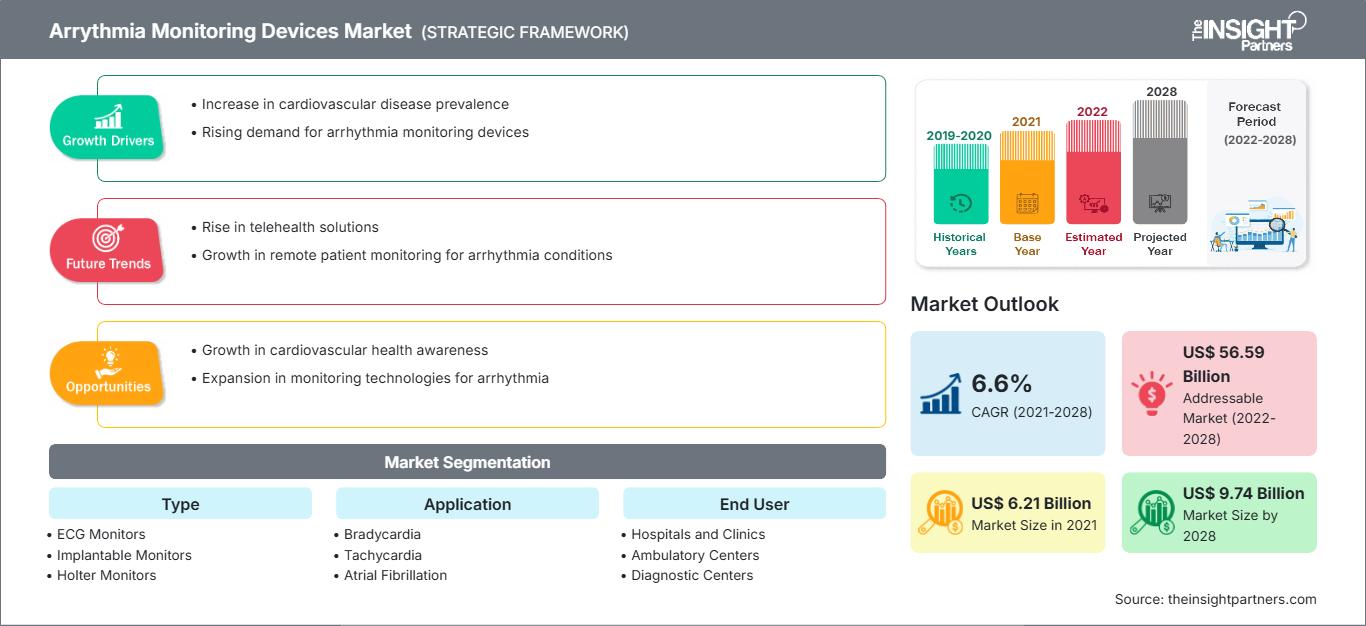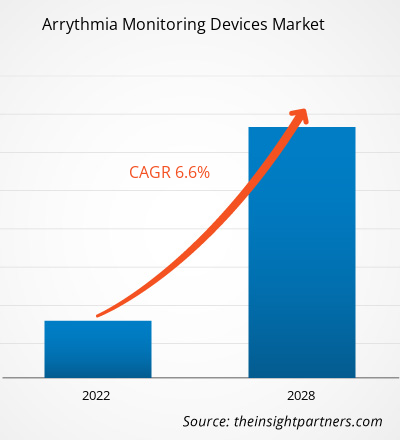Se prevé que el mercado de dispositivos de monitorización de arritmias alcance los 9.742,95 millones de dólares estadounidenses en 2028, frente a los 6.212,59 millones de dólares estadounidenses en 2021; se espera que crezca a una tasa de crecimiento anual compuesta (TCAC) del 6,6% entre 2021 y 2028.
El aumento de la incidencia de enfermedades cardiovasculares y el envejecimiento de la población son los principales factores que impulsan el crecimiento del mercado. Sin embargo, el elevado coste de los productos y procedimientos lo limita. La arritmia se refiere a irregularidades en los latidos del corazón, en las que este puede latir demasiado rápido o demasiado lento. Los dispositivos de monitorización de arritmias se utilizan para controlar la función cardíaca, manteniendo un registro continuo de su actividad e informando sobre cualquier anomalía en el ritmo cardíaco.
Los países de Asia-Pacífico están experimentando un aumento en los casos de COVID-19. Como parte de su impacto a corto plazo, la pandemia ha puesto de manifiesto la necesidad de revisar los procesos regulatorios e introducir cambios en los procesos de investigación y desarrollo. Además, se ha producido una disminución significativa en las visitas de pacientes hospitalizados y ambulatorios en las cadenas de hospitales privados. Para aliviar la presión sobre los sistemas de salud, muchas clínicas han pospuesto cirugías cardíacas no urgentes. Según un informe publicado en el British Journal of Surgery, se estima que en India se cancelan 48.728 operaciones por semana. Es probable que estos acontecimientos tengan un impacto negativo en el mercado de dispositivos de monitorización de arritmias en Asia-Pacífico.
Obtendrá personalización en cualquier informe, sin cargo, incluidas partes de este informe o análisis a nivel de país, paquete de datos de Excel, así como también grandes ofertas y descuentos para empresas emergentes y universidades.
Mercado de dispositivos de monitorización de arritmias: Perspectivas estratégicas

-
Obtenga las principales tendencias clave del mercado de este informe.Esta muestra GRATUITA incluirá análisis de datos, desde tendencias del mercado hasta estimaciones y pronósticos.
Perspectivas del mercado
El aumento de la incidencia de enfermedades cardiovasculares impulsa el crecimiento del mercado de dispositivos de monitorización de arritmias.
En la última década, el mundo ha presenciado avances notables en los dispositivos de monitorización de arritmias, ofreciendo a médicos y pacientes nuevos enfoques para el manejo de diversas enfermedades, incluyendo arritmias auriculares, arritmias ventriculares y fibrilación auricular ventricular. La creciente prevalencia de arritmias y otras enfermedades cardiovasculares (ECV), como bradicardia, taquicardia, fibrilación auricular, fibrilación ventricular y extrasístoles ventriculares, está impulsando la introducción de métodos diagnósticos mejorados. Los sistemas de monitorización cardíaca son herramientas más sencillas y rápidas para la detección de arritmias, lo que ha contribuido a su popularidad. Según la Organización Mundial de la Salud (OMS), las ECV se encuentran entre las principales causas de muerte a nivel mundial, y aproximadamente 30 millones de personas sufren un accidente cerebrovascular cada año. Según la Asociación Americana del Corazón, casi la mitad de los adultos en Estados Unidos padecen algún tipo de ECV. Además, se prevé que más de 130 millones de personas, es decir, el 45,1 % de la población estadounidense, padecerán algún tipo de enfermedad cardiovascular (ECV) para 2035. Asimismo, los cambios en el estilo de vida están provocando un aumento en la incidencia de enfermedades como la diabetes, la hipertensión, la dislipidemia y la obesidad, lo que contribuye a un incremento de los casos de ECV en todo el mundo. La mayoría de las ECV se pueden prevenir mediante la monitorización y el diagnóstico precoz. De igual manera, las arritmias, es decir, las anomalías en el funcionamiento del corazón, se pueden evitar con un diagnóstico temprano. La demanda de dispositivos de monitorización de arritmias está aumentando, ya que estos dispositivos pueden ayudar a salvar a pacientes con alto riesgo de sufrir un paro cardíaco.
Perspectivas basadas en tipos
Según su tipo, el mercado de dispositivos para la monitorización de arritmias se segmenta en monitores de ECG, monitores implantables, monitores Holter, telemetría cardíaca móvil y otros. El segmento de monitores Holter representó la mayor cuota de mercado en 2020. Estos monitores son una de las opciones preferidas para la monitorización cardíaca. Además, permiten un uso prolongado para el diagnóstico de síntomas esporádicos y ofrecen una monitorización más rápida y cómoda. Sin embargo, se prevé que el segmento de telemetría cardíaca móvil experimente el mayor crecimiento anual compuesto (CAGR) durante el período 2021-2028.
Información basada en aplicaciones
Según su aplicación, el mercado de dispositivos para la monitorización de arritmias se segmenta en bradicardia, taquicardia, fibrilación auricular, fibrilación ventricular, extrasístoles ventriculares y otras. El segmento de fibrilación auricular representó la mayor cuota de mercado en 2020 y se estima que registrará la mayor tasa de crecimiento anual compuesto (TCAC) durante el período de previsión. El crecimiento del mercado de la fibrilación auricular se puede atribuir a la creciente prevalencia de esta afección y al envejecimiento de la población.
Información basada en el usuario final
Según el usuario final, el mercado de dispositivos de monitorización de arritmias se segmenta en hospitales y clínicas, centros ambulatorios, centros de diagnóstico y otros. El segmento de hospitales y clínicas representó la mayor cuota de mercado en 2020. El creciente número de hospitales multiespecialidad y la preferencia de la población por los hospitales frente a otros centros sanitarios son los principales factores que impulsan el crecimiento de este segmento. Sin embargo, se prevé que el segmento de centros ambulatorios registre la mayor tasa de crecimiento anual compuesto (TCAC) durante el periodo de previsión.
Las empresas que operan en el mercado de dispositivos de monitorización de arritmias hacen hincapié en la adopción de una estrategia de innovación de productos para satisfacer las cambiantes demandas de los clientes en todo el mundo, lo que también les permite mantener su marca en el mercado global.
Perspectivas regionales del mercado de dispositivos de monitorización de arritmias
Los analistas de The Insight Partners han explicado en detalle las tendencias regionales y los factores que influyen en el mercado de dispositivos de monitorización de arritmias durante el período de previsión. Esta sección también analiza los segmentos de mercado y la distribución geográfica de estos dispositivos en Norteamérica, Europa, Asia Pacífico, Oriente Medio y África, y Sudamérica y Centroamérica.
Alcance del informe de mercado de dispositivos de monitorización de arritmias
| Atributo del informe | Detalles |
|---|---|
| Tamaño del mercado en 2021 | 6.210 millones de dólares estadounidenses |
| Tamaño del mercado para 2028 | 9.740 millones de dólares estadounidenses |
| CAGR global (2021-2028) | 6,6% |
| Datos históricos | 2019-2020 |
| Período de pronóstico | 2022-2028 |
| Segmentos cubiertos |
Por tipo
|
| Regiones y países cubiertos |
América del norte
|
| Líderes del mercado y perfiles de empresas clave |
|
Densidad de los participantes en el mercado de dispositivos de monitorización de arritmias: comprensión de su impacto en la dinámica empresarial
El mercado de dispositivos de monitorización de arritmias está creciendo rápidamente, impulsado por la creciente demanda de los usuarios finales debido a factores como la evolución de las preferencias de los consumidores, los avances tecnológicos y una mayor concienciación sobre los beneficios del producto. A medida que aumenta la demanda, las empresas amplían su oferta, innovan para satisfacer las necesidades de los consumidores y aprovechan las nuevas tendencias, lo que impulsa aún más el crecimiento del mercado.

- Obtenga una visión general de los principales actores del mercado de dispositivos de monitorización de arritmias.
Mercado de dispositivos de monitorización de arritmias – por tipo
- Monitores de ECG
- Monitores implantables
- Monitores Holter
- Telemetría cardíaca móvil
- Otros
Mercado de dispositivos de monitorización de arritmias: por aplicación
- Bradicardia
- Taquicardia
- Fibrilación auricular
- Fibrilación ventricular
- Contracción prematura
- Otras aplicaciones
Mercado de dispositivos de monitorización de arritmias – por usuario final
- Hospitales y Clínicas
- Centros ambulatorios
- Centros de diagnóstico
- Otros usuarios finales
Mercado de dispositivos de monitorización de arritmias – por geografía
-
América del norte
- A NOSOTROS
- Canadá
- México
-
Europa
- Francia
- Alemania
- Italia
- Reino Unido
- España
- Resto de Europa
-
Asia Pacífico (APAC)
- Porcelana
- India
- Corea del Sur
- Japón
- Australia
- Resto de APAC
-
Oriente Medio y África (MEA)
- Sudáfrica
- Arabia Saudita
- Emiratos Árabes Unidos
- Resto de MEA
-
América del Sur y Central (SCAM)
- Brasil
- Argentina
- Resto de ESTAFA
Perfiles de empresas
- Abbott
- Koninklijke Philips NV
- Compañía General Electric
- Hill-Rom Holding Inc.
- Medtronic
- Biotronik, Inc.
- AliveCor, Inc
- Diagnóstico ACS
- Algoritmos médicos
- Sistemas OSI, Inc.
- Análisis histórico (2 años), año base, pronóstico (7 años) con CAGR
- Análisis PEST y FODA
- Tamaño del mercado, valor/volumen: global, regional y nacional
- Industria y panorama competitivo
- Conjunto de datos de Excel
Informes recientes
Testimonios
Razón para comprar
- Toma de decisiones informada
- Comprensión de la dinámica del mercado
- Análisis competitivo
- Información sobre clientes
- Pronósticos del mercado
- Mitigación de riesgos
- Planificación estratégica
- Justificación de la inversión
- Identificación de mercados emergentes
- Mejora de las estrategias de marketing
- Impulso de la eficiencia operativa
- Alineación con las tendencias regulatorias






















 Obtenga una muestra gratuita para - Mercado de dispositivos de monitorización de arritmias
Obtenga una muestra gratuita para - Mercado de dispositivos de monitorización de arritmias